Oil Soluble Additives
-
- MARINE LUBRICANTS MEETING THE DEMANDS OF NEW AND UPGRADED DIESELS Maritime Reporter, Jul 1989 #36
The trend toward upgrading output and efficiency of marine diesel engines, as well as improving their ability to burn heavy residual fuels with high sulfur content, has placed increasing demands on the petroleum industry to improve their products. The oil producers have responded by offering new and reformulated marine lubricants, including highly alkaline cylinder oils to protect against the acidity resulting from the burning of residual fuels, and improved system oils to meet the severe-service demands of the latest engines.
The following review is based on data supplied by the major producers of marine lubricants. Free brochures and data sheets giving full details on the formulations and capabilities of these oils are available from all of the producers included in this review. To obtain copies, just circle the appropriate Reader Service Number(s) on the postage-paid card in the back of this issue.
CASTROL MARINE Circle 101 on Reader Service Card Castrol Marine has always been a leader and innovator in the lubricant market by supplying quality products and service to meet changing customer needs. Castrol Marine became one of the first major lubricant manufacturers to offer the next generation crosshead cylinder oil, when it introduced Castrol Cyltech 80 to the marine market. Full information on the performance advantages and overall cost savings of Castrol Cyltech 80 is detailed in a brochure, which is available upon request.
In addition to Cyltech 80, Castrol has recently introduced other products to meet customer needs, such as the Castrol MLC series and Castrol CDX. The firm's approach is to offer specialized products for specific applications, which take into account vessel trade patterns, fuel quality and other variables.
Regarding service facilities, Castrol Marine has true bulk availability at all major world ports. In the U.S., Castrol has manufacturing facilities in New Jersey, Louisiana, and California, and has bulk inventory in nine other locations.
Because of its experience and trained personnel, Castrol can offer extra service whenever needed.
CHEVRON Circle 40 on Reader Service Card Chevron has recently introduced Chevron DELO Marine Oil 477 for the inland marine trade class. It is marketed as Chevron DELO 6170 Oil for customers on the western and eastern seaboard.
Chevron's DELO Marine Oil 477 (DELO 6170 Oil) is test proven, demonstrating superior results in the field for today's new generation high-performance diesel engines.
This product is designed especially for use in engines for towboat service where some current lubricants may have limited performance and is compounded to a high alkalinity level, measuring 17 TBN (Total Base Number) by ASTM Method D-2896.
New engine designs require improved oxidation and viscosity control for operating demands of fuel efficient engines with higher combustion pressures and temperatures.
Increased alkalinity reserve is required for corrosive wear protection and especially for operations requiring extended drain intervals.
DELO Marine Oil 477 (DELO 6170 Oil) was field tested in marine and locomotive service in GE and EMD engines with full approval from these engine manufacturers.
Field testing demonstrated increased oxidation and viscosity control compared to typical Generation 4 lubricants. This increased oil control can allow increased drain intervals for GE engines and due to increased drain intervals, the added alkalinity reserve also provides the ability to extend drain intervals.
This superior oxidation stability and viscosity control was also demonstrated in EMD engines modified to run at higher operating temperatures to increase efficiency.
Chevron DELO Marine Oil 477 (DELO 6179 Oil) provides an optimized engine oil formulation for today's service requirements for industrial engine design in marine towboat and ferry service.
EXXON Circle 103 on Reader Service Card Diesel lubricants will continue the tradition of meeting the challenge of future high performance diesel engines. However their misuse, disregard of standard precautions and the pursuit of expedient solutions to operational or design problems, all invariably result in costly inefficiencies. This is the theme of a paper presented at the 18th CIMAC Congress in Tianjin, PRC this June.
Higher wear occurs within cylinders because of poor combustion that can severely over-heat metal surfaces and produce excessive deposits.
Superior quality lubricants are of little use in such circumstances and can not make up for inadequate fuel injection when this results in impingement of unburnt fuel on cylinder liners, which washes away the oil film.
Adequate oil supply to the sliding surfaces must be ensured at all times. Monetary savings achieves through reduction of oil consumption are illusory when, longer term, they result in reduced cylinder liner life and increased maintenance costs. Over-lubrication should also be avoided because of its economic and technical drawbacks. In essence, the lubricant supply should be dictated by what the engine really needs for proper operation.
Over-cooling, either through incorrect design or operation, should be avoided since it causes excessive corrosive wear. Higher alkalinity lubricants are generally able to control higher corrosive wear but are an expedient rather than an efficient solution. Adjustments and modifications to engine design and operation can reduce wear rates to the same low levels afforded by considerably higher alkalinity, hence higher cost lubricants.
Good care of lubricants is also a source of savings. For instance, if continuous water-washing of the lubricant through a faulty solenoid valve in the centrifuging system goes undetected, the alkalinity of the lubricant would be affected. The control of wear and cleanliness of the engine would be impaired and an expensive renewal of the oil change may be needed.
In conclusion, incorrect use of lubricants is ineffient and essentially a disservice to the shipping industry.
Reprints of the Exxon paper "Marine Diesel Lubricants: Uses and Abuses," are available on request from Exxon Company International, 200 Park Avenue, Florham Park, NJ 07928.
MOBIL Circle 104 on Reader Service Card Mobil Oil Corporation announced in 1989 the introduction of a new marine diesel engine lubricant product line—Mobilmar. Mobilmar diesel engine oils are formulated specifically for diesel engines used in marine applications. These new oils provide superior wear protection, excellent soot and high temperature deposit control, excellent alkalinity retention, and storage stability.
Added features to these new Mobil marine lubricants are: excellent water separation characteristics and corrosion protection. Mobilmar 100 Series Oils have been designed to give optimum performance in Marine applications of Detroit Diesel engines, while providing good diesel performance in fleets with mixed engines; including Caterpillar engines.
Mobilmar 300 Series Oils have been designed to give optimum performance in Caterpillar marine applications and meet the quality characteristics needed for the Caterpillar 3600 Series and 3500 Series engines.
In keeping with this approach to marine diesel engine lubrication, Mobil has also enhanced Mobilgard 450 oil to assure optimum non-zinc performance in EMD engines. Mobilgard 450 provides optimum performance for EMD engines, as well as all auxiliary and main marine engines requiring a CD-type diesel engine oil.
The Mobilgard series of marine engine oils includes Mobilgard 570, a quality marine diesel engine cylinder oil formulated to provide outstanding performance in high-output crosshead engines with brake mean effective pressures (BMEP) of 14 to 17 bar. These highly loaded crosshead diesels operate on heavy fuel oil With high sulfur content in order to reduce operating costs.
Concurrently, advances in engine thermodynamics have permitted decreases in specific fuel consump- tion from 155 to 125 per bhp-hour.
These changes in engine design for greater fuel efficiency, the use of higher viscosity residual fuels, and the need for reduced maintenance have increased the requirements on crosshead cylinder oil.
Mobilgard 570 was developed to provide high load-carrying characteristics, improved spreadability, tenacious film retention, and to minimize port and piston deposits.
Because of its high alkalinity (70 Total Base Number or TBN), it provides better protection against corrosive wear by neutralizing large amounts of strong acids. This oil is compatible with oils normally used in the crankcase of crosshead engines.
Mobilgard 300 system oil was also developed especially for modern, high-output, crosshead type marine diesel engines. It is formulated from highly treated paraffinic base oils that are selected for their thermal stability and oxidation resistance.
The inherent base oil characteristics are augmented with a balanced additive package including high-temperature oxidation inhibitors, alkaline detergent-dispersants, and deft foamants. The formulation has maximum antiwear properties, good rust protection in the presence of salt water, and excellent water separation characteristics.
The Mobilgard 24 series oils were developed originally to meet the requirements of medium-speed, trunk piston diesels used for main propulsion engines on coastal and river vessels. The series was reformulated recently to provide improved performance in the new, higher-output versions of these engines now coming into service.
The Mobilgard 42 series of marine lubricating oils has been developed to supplement the Mobilgard 24 series (30 TBN) oils for the lubrication of modern high-output, medium- speed trunk diesel engines used in oceangoing vessels and ferries.
Mobilgard 42 oils have an alkalinity level of 40 TBN and are therefore particularly suitable for engines that show indication of corrosive wear to cylinder liners and piston rings.
Mobilgard SHC 120 is a 12 TBN synthetic, medium-speed diesel lubricant.
It contains a balanced blend of synthesized hydrocarbons and ester-based fluids, with an additive system designed to provide optimum performance in diesel engines.
Although its measured viscosity indicates that it is an SAE 40 grade, this oil's inherent high index enables it to perform similar to an SAE 15W-40 viscosity grade diesle engine lubricant. It is formulated for operation in extremes of ambient temperature.
The Mobilgard 12 series oils are intended for marine diesels operating in distillate fuels or light fuel blends. These oils have proven especially effective in small-bore, highspeed trunk engines and automotive- type diesels used in fishing fleets, the new severe service engines and in several types of medium- speed trunk piston engines.
The oils come in viscosities of SAE 30, SAE 40 and SAE 50 and have a TBN of 15.
Other marine lubricants are available.
PENNZOIL Circle 105 on Reader Service Card In the small workboat and fishing vessel market, two-cycle outboard engines offer the performance advantages of high horsepower and light weight, as compared to a fourcycle engine design. Unfortunately, two-cycle outboard engines have special lubrication requirements, and care must be taken to select the proper lubricant.
The lubrication of two-cycle engines is accomplished by the mixing the oil with the fuel, either by premixing oil and fuel in the fuel tank or by an automatic injection system.
As this mixture is drawn into the engine, the fuel evaporates, and oil is left behind to lubricate the bearings, cylinders, pistons and rings.
Excess oil is drawn into the combustion chambers where it is burned along with the fuel.
Because oil is burned along with the gasoline, two-cycle engines are especially prone to deposits in the combustion chambers, exhaust ports, piston rings and spark plugs.
Therefore, special ashless-type detergent additives are blended into the oil to prevent deposit formation.
The detergent additives blended into passenger car motor oils are compounds usually containing metals such as calcium and magnesium.
When burned, these motor oils would leave behind an ash residue containing these metals. Ashless detergents used in two-cycle oils do not contain these metal compounds, and when burned, leave behind no ash deposits to foul spark plugs, stick rings, or block exhaust ports.
All major outboard engine manufacturers require the lubricant used in their two-cycle engine be approved by the National Marine M a n u f a c t u r e r s Association (NMMA). This organization has standardized tests to measure an oil's ability to protect an outboard engine from rust, deposits, pre-ignition, and piston scuffing. In fact, this organization has just introduced a more rigorous test procedure and specification. Designated TC-W II, this specification includes more severe engine testing to measure the oil's lubrication ability and pre-ignition tendencies, higher fuel/ oil ratios in the general performance engine testing to simulate the new 100:1 fuel-to-oil mixtures produced by the new Variable Ratio Oil (VRO) injection systems, and new tests to measure the oil's low temperature fluidity and resistance to gel formation.
Pennzoil Premium Outboard Lubricant was reportedly the first major oil brand to be approved by the NMMA as a TC-W II lubricant.
Pennzoil has taken extensive steps to insure the quality and performance of this product. Pennzoil manufactures its Premium Outboard Lubricant "in-house" instead of using a contract blender/packager.
Pennzoil has installed a totally dedicated system for handling this product's raw material ingredients, blending and packaging the finished outboard oil in quart bottles, gallon jugs, and 55-gallon drums. Pennzoil has also enacted very strict quality control procedures involving extensive testing of both raw materials and finished product.
Pennzoil's unending commitment to quality, in conjunction with the new NMMA TC-W II specification, assures the consumer that Pennzoil Premium Outboard Lubricant gives the consumer the ultimate in engine performance and protection.
TEXACO Circle 110 on Reader Service Card Texaco offers a complete line of quality marine lubricants which are available worldwide to meet the needs of all types of marine equipment.
For crosshead engines, Texaco offers TARO Special, a premium quality cylinder lubricant for large, slow-speed diesels burning residual fuels. It is blended from highly refined paraffinic base oils and oil soluble additives to produce a high alkaline reserve (70 TBN) product with good lubricant film strength. It is approved by all of the major crosshead engine builders. It is specially formulated to prevent corrosive wear and minimize ring deposits.
Taro Special EX 85 is a premium quality cylinder lubricant specifically developed to meet the requirements of Sulzer RLB engines. It has provided excellent performance in field tests and is approved by Sulzer for those applications where an 85 TBN product with a viscosity of 24 est at 100 degrees C is specified.
DORO AR 30 (SAE 30) is a premium crankcase lubricant for large, slow-speed engines. It is blended from highly refined solvent neutral oils and carefully selected additives to produce a moderate alkaline reserve (6 TBN) oil. This product offers unusually good rust and corrosion protection, wear protection and water separation characteristics.
DORO AR 30 meets the Sulzer requirement for engines equipped with PTO units.
Texaco offers a complete line of trunk piston engine oils for medium and high-speed diesels. The specific lubricant required would be based on the sulfur content of the fuel being used in the engine. TARO XD oils, with a TBN of 15 minimum, are used in engines burning fuel with a sulfur content up to 1.8 percent.
TARO DP oils, with a TBN of 30 minimum, are specifically designed for trunk type engines utilizing fuel with sulfur in excess of 1.8 percent.
TARO XD and TARO DP are available in SAE 30 and SAE 40 viscosity grades. TARO XL 40 (SAE 40) is for use in medium-speed engines where the operating conditions or fuel sulfur content requires a 40 TBN product.
All of these oils are blended from carefully refined base oils fortified with specially developed additive packages to give excellent perform- ance even under the most severe operating conditions. They have been extensively tested both in the laboratory and in the field. TARO XD, DP and XL 40 all offer excellent TBN retention and anti-corrosion properties. They are formulated with selected detergent and dispersant additives which minimize piston ring deposits, improve overall engine cleanliness and provide long in-service life.
Texaco supports its marine lubricants with prompt, efficient technical service and the Texlube used oil analysis program for monitoring the condition of the oils in use.
UNITOR Circle 106 on Reader Service Card The marketing of fuel treatments by Unitor Ships Service A/S has r e c e n t l y been dramatically strengthened by the acquisition of supplier Gamlen Chemical Company.
Unitor marine chemicals are now drawn from the combined resources and expertise of both Perolin Marine, long know for its fuel treatments, and Gamlen Chemical Co. The result is a highly efficient and cost-effective range of fuel treatments, cleaners, and water treatments.
Unitor offers treatment products for such fuel handling system problems as sludge, water contamination, corrosion and bacteria/fungi.
A fuel conditioner such as Unitor's Fuelcare is effective against sludge formation in unstable fuels. The instability can have been caused by aging or long term heating, or by mixing incompatible fuels aboard.
Sludgy fuels often entrain water, thus by dispersing existing sludge and by preventing incompatibility, water contamination can be released for removal by settling/centrifuge.
Corrosion is prevented by the filming action of the fuel conditioner.
The additive also chemically neutralizes acids in the fuel.
Where bacteria/fungi are present, it is first necessary to remove as much water as possible from the fuel and then to treat with a biocide.
The biocide Bioclean is a "broad spectrum" biocide, meaning it is effective in killing a wide range of bacteria and fungi, an essential requirement for fuels since exact type of bio-activity is often not known.
Water contamination, especially saltwater contamination, in fuel can cause costly problems during combustion, such as high temperature corrosion of engine components by ash deposits. Fortunately, high temperature corrosion and ash deposition problems can be terated with additives such as Burnall or Cleanburn, which are effective in both these areas. With the use of a fuel conditioner these problems as well as storage tank and pipeline corrosion can be avoided.
Unitor also offers Gamabreak, a versatile and effective water demulsifying additive.
-
- ANNUAL GUIDE TO FUELS and LUBES Maritime Reporter, Jul 1992 #38
generation of high-output engines, additives must be used in lubricants. And although the use of additives in internal combustion engine lubricating oils is nothing new, having begun over 70 years ago, recent advancements in organic chemistry have led to excellent results with new additives. Some
-
- MARINE LUBRICANTS Maritime Reporter, Jul 1990 #28
to burn heavy residual fuels with high sulfur content, has placed increasing demands on the petroleum industry to improve their products. The oil producers have responded by offering new and reformulated marine lubricants, including highly alkaline cylinder oils to protect against the acidity
-
- MARINE LUBRICANTS MEETING THE DEMANDS OF NEW AND UPGRADED DIESELS Maritime Reporter, Jul 1988 #52
to burn heavy residual fuels with high sulfur content, has placed increasing demands on the petroleum industry to improve their products. The oil producers have responded by offering new and reformulated marine lubricants, including highly alkaline cylinder oils to protect against the acidity
-
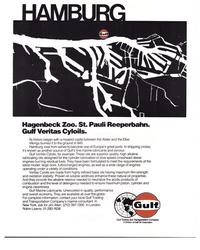 )
August 1977 - Maritime Reporter and Engineering News page: 2nd Cover
)
August 1977 - Maritime Reporter and Engineering News page: 2nd Covera variety of conditions. Veritas CyloHs are made from highly refined base oils having maximum film strength and oxidation stability. Proven oil soluble additives enhance these natural oil properties. And they provide the alkaline reserve needed to neutralize the acidic products of combustion and
-
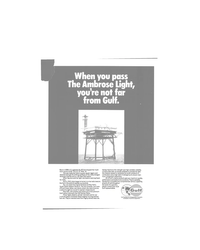 )
January 1980 - Maritime Reporter and Engineering News page: 2nd Cover
)
January 1980 - Maritime Reporter and Engineering News page: 2nd Cover, a welcome sight (or sound) to seamen inward bound. New York. Still another port where you'll find premium Gulf marine lubricants like Gulf Veritas Cyloils. These highly alkaline cylinder lubricants are for use in all low-speed crosshead diesel engines burning residual fuel oils. They're manufactured
-
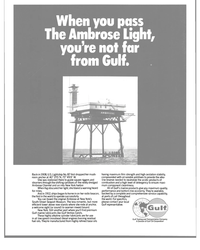 )
February 15, 1980 - Maritime Reporter and Engineering News page: 4th Cover
)
February 15, 1980 - Maritime Reporter and Engineering News page: 4th Covera welcome sight (or sound) to seamen inward bound. New York. Still another port where you'll find premium Gulf marine lubricants like Gulf Veritas Ctyloils. These highly alkaline cylinder lubricants are for use in all low-speed crosshead diesel engines burning residual fuel oils. They're manufactured
-
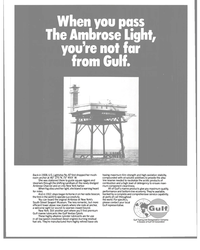 )
March 1980 - Maritime Reporter and Engineering News page: 2nd Cover
)
March 1980 - Maritime Reporter and Engineering News page: 2nd Cover, a welcome sight (or sound) to seamen inward bound. New York. Still another port where you'll find premium Gulf marine lubricants like Gulf Veritas Cyloils. These highly alkaline cylinder lubricants are for use in all low-speed crosshead diesel engines burning residual fuel oils. They're manufactured
-
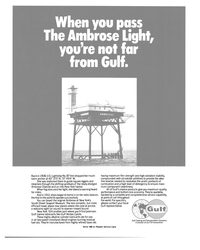 )
January 1981 - Maritime Reporter and Engineering News page: 2nd Cover
)
January 1981 - Maritime Reporter and Engineering News page: 2nd Cover, a welcome sight (or sound) to seamen inward bound. New York. Still another port where you'll find premium Gulf marine lubricants like Gulf Veritas Cyloils. These highly alkaline cylinder lubricants are for use in all low-speed crosshead diesel engines burning residual fuel oils. They're manufactured
-
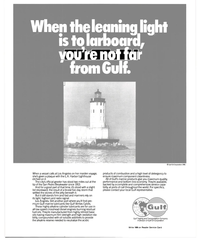 )
April 1981 - Maritime Reporter and Engineering News page: 2nd Cover
)
April 1981 - Maritime Reporter and Engineering News page: 2nd CoverWhen the leaning light is to larboard, MUi 4iIo I r-1 r m i from Gulf. © Gulf Oil Corporation 1981 When a vessel calls at Los Angeles on her maiden voyage, she's given a plaque with the L.A. Harbor Lighthouse etched on it. The city's official greeter has stood two miles out at the tip of
-
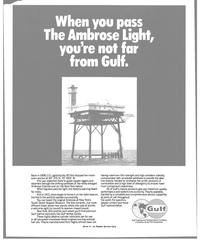 )
October 1981 - Maritime Reporter and Engineering News page: 2nd Cover
)
October 1981 - Maritime Reporter and Engineering News page: 2nd Cover, a welcome sight (or sound) to seamen inward bound. New York. Still another port where you'll find premium Gulf marine lubricants like Gulf Veritas Cyloils. These highly alkaline cylinder lubricants are for use in all low-speed crosshead diesel engines burning residual fuel oils. They're manufactured
